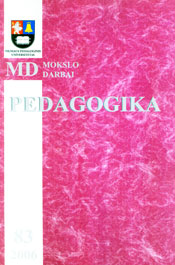Grindžiamoji teorija – kokybinė edukologijos tyrimų metodologijos strategija
Grounded Theory-A Qualitative Strategy of Research Methodology in Education
Author(s): Akvilė Virbalienė, Vilma Žydžiūnaitė, Eglė KatiliūtėSubject(s): Education
Published by: Vytauto Didžiojo Universitetas
Keywords: grounded theory; category; coding; central phenomenon.
Summary/Abstract: In the article here is presented the concept of grounded theory as qualitative research methodology, as it is the research focus of presented descriptive research too. Research aim is to describe the peculiarities of grounded theory in the process of qualitative research methodology in education. Questions from which consists the research problem are the following: what are advantages, limits and specific features in collecting and analyzing the data of grounded theory research process? Grounded theory is one possibility within the naturalistic – inductive paradigm. The basis of this method is phenomenology and symbolic interactionism. The term “grounded” indicates that the theory is based on empirical findings. The term “theory” stresses that the purpose of this method is to develop either a substantial theory (a description about some parts of reality) or a formal theory (a general theory about some phenomenon). The methodological aim of grounded theory is to generate or discover theory substantiated by abstract scheme of phenomenon, which is related to concrete studied situation. This is the situation where people interact, perform activities and are involved into process of content of concrete phenomenon. A category in the study based on grounded theory methodology, is the unit of information about events, interactions and etc. By performing research the researcher should visit the field (research area) several times, where he / she will collect the data. The data is analyzed straight after every visit. The data collection continues until the categories are formed. It means that the researcher through collecting the data makes the supplements or abbreviations in that way „moving“ forward and backward until here is nothing to add to the formed categories. The moving forward and backward means „going“ to concrete field to collect the information: backward – to substantiate the analyzed data; forward – again to the field to collect more information and again backward – to analyze the data and etc. It is adequate to process of dialogue and opposite to traditional one – way linear process, where firstly is collected the data, and after the data is analyzed. The formed theory should be substantiated by collected data in research study, especially by concentrating on actions, interactions and social processes among people. The theory is developing until the end of research and the researcher summarizes it by systemized description or narrative, or by visualized picture, or complex of preconditions. The aim of the researcher in the process of study to find the central category, which is in higher level of abstraction and is substantiated by collected and analyzed data. ...
Journal: Pedagogika
- Issue Year: 2006
- Issue No: 83
- Page Range: 57-63
- Page Count: 7
- Language: Lithuanian

